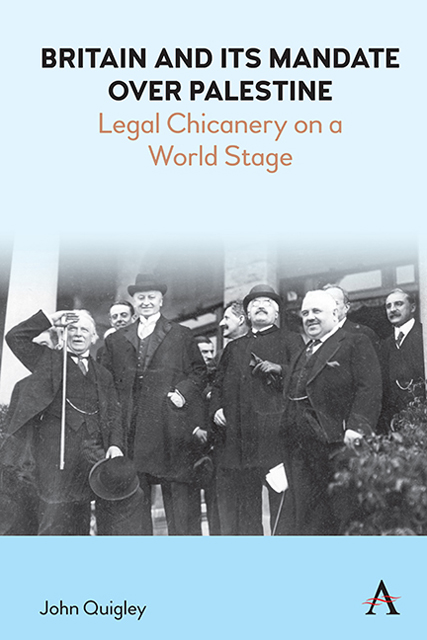Book contents
- Frontmatter
- Contents
- Preface
- Setting the Stage: Was Britain’s Rule in Palestine Legal?
- 1 The Balfour Declaration Is the Focal Point for the Legal Situation of Palestine
- 2 The Balfour Declaration Was a Binding Commitment to the Jewish People
- 3 The Jewish National Home Meant a Jewish State
- 4 The Balfour Declaration Was Issued to Affirm Jewish Rights in Palestine
- 5 The Paris Peace Conference Raised Jewish Statehood to the International Level
- 6 Britain’s Allies Made the Balfour Declaration an International Commitment
- 7 Britain’s Allies Endorsed Jewish Rights
- 8 Britain Took on Palestine Because of the League’s Mandate System
- 9 The League of Nations Protected Palestine’s Arab Population
- 10 Britain Was Given Palestine by the League of Nations
- 11 The League of Nations Put the Palestine Mandate into Legal Force
- 12 The Peace Treaty with Turkey Legalized Britain’s Status in Palestine
- 13 The Palestine Mandate Document Was a Treaty between Britain and the League
- 14 The League of Nations Required Britain to Implement the Balfour Declaration
- 15 The Palestine Mandate Document Implemented the League Covenant
- 16 The Palestine Mandate Document Recognized Jews as a National Group
- 17 The Palestine Mandate Document Bound Britain to the Balfour Declaration
- 18 The International Community Committed Itself to the Balfour Declaration
- 19 Britain Held Legal Status in Palestine
- 20 The United Nations Charter Carried Forward a Jewish Entitlement to Statehood
- Postscript: Why History Matters
- Documents Annex
- Notes
- Bibliography
- Index
13 - The Palestine Mandate Document Was a Treaty between Britain and the League
Published online by Cambridge University Press: 10 January 2023
- Frontmatter
- Contents
- Preface
- Setting the Stage: Was Britain’s Rule in Palestine Legal?
- 1 The Balfour Declaration Is the Focal Point for the Legal Situation of Palestine
- 2 The Balfour Declaration Was a Binding Commitment to the Jewish People
- 3 The Jewish National Home Meant a Jewish State
- 4 The Balfour Declaration Was Issued to Affirm Jewish Rights in Palestine
- 5 The Paris Peace Conference Raised Jewish Statehood to the International Level
- 6 Britain’s Allies Made the Balfour Declaration an International Commitment
- 7 Britain’s Allies Endorsed Jewish Rights
- 8 Britain Took on Palestine Because of the League’s Mandate System
- 9 The League of Nations Protected Palestine’s Arab Population
- 10 Britain Was Given Palestine by the League of Nations
- 11 The League of Nations Put the Palestine Mandate into Legal Force
- 12 The Peace Treaty with Turkey Legalized Britain’s Status in Palestine
- 13 The Palestine Mandate Document Was a Treaty between Britain and the League
- 14 The League of Nations Required Britain to Implement the Balfour Declaration
- 15 The Palestine Mandate Document Implemented the League Covenant
- 16 The Palestine Mandate Document Recognized Jews as a National Group
- 17 The Palestine Mandate Document Bound Britain to the Balfour Declaration
- 18 The International Community Committed Itself to the Balfour Declaration
- 19 Britain Held Legal Status in Palestine
- 20 The United Nations Charter Carried Forward a Jewish Entitlement to Statehood
- Postscript: Why History Matters
- Documents Annex
- Notes
- Bibliography
- Index
Summary
The 1948 declaration of Israeli statehood cited the Palestine mandate document as an affirmation of Jewish legal rights. Moshe Sharett, who would become prime minister of Israel, called the mandate document “an open covenant, openly agreed to by the League of Nations.” “With the Balfour Declaration,” Sharett said, the Palestine mandate document was “an international instrument guaranteeing to the Jewish people special facilities for immigration and settlement throughout Palestine.”
Yoram Dinstein put Sharett's statement into legal terms. “The Mandate for Palestine,” wrote Dinstein, “was an international agreement concluded between the League of Nations, on the one hand, and the Mandatory Power (Britain), on the other. It was not only Britain that was bound by the instrument, but also the League of Nations (the international organization in which most of the then-existing states of the world were members).” “International agreement” is another way of saying “treaty.”
We have just seen, of course, that the mandate document was never finalized. Since Britain never gained sovereignty in Palestine, it could not hold a mandate. Even if one overlooks that defect, however, the Palestine mandate document would not qualify as a treaty.
Dinstein did not elaborate to explain his characterization of the mandate document. On its face, the document does not bear the appearance of a treaty. Its full text can be found in the Documents Annex. It begins with the phrase “The Council of the League of Nations” and then recites terms. It reads like a document that, as is stated in it a few lines later, “confirms” what has been submitted to it. A treaty, at least one that is memorialized in a single document, would bear the names of the parties as having come to an agreement. Britain's name does not appear as a party to the document.
A treaty is normally signed on behalf of the parties. The Palestine mandate document bore no signatures. Signatures attest that a treaty was negotiated by persons with the authority to do so on behalf of the parties. Treaties on significant matters are normally signed subject to ratification. No ratification was contemplated for the Palestine mandate document.
- Type
- Chapter
- Information
- Britain and its Mandate over PalestineLegal Chicanery on a World Stage, pp. 97 - 104Publisher: Anthem PressPrint publication year: 2022

